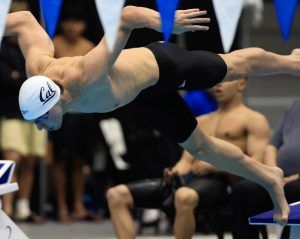
Katie Ledecky and The Power of Asking “Why Not?”
Swimmers often find themselves stuck with doubt when it comes to doing tough things in the water. Here’s a simple question to ask when you find doubt and uncertainty stopping you from excellence.

Dreaming big with your goals is a lot of fun. Until you realize the other side of it—what might happen if you fail. Here’s a strategy to help you commit to big and scary goals in the pool.
Setting goals is something all swimmers do in the pool.
Whether it’s setting out to go a best time, go to the Olympics, or swim a big, open-water race, we all have goals in the water.
In this article, I am going to discuss the two sides of Big Goals, (Excitement and Dread), and talk about how you can master both for more progress in the water.
Sounds good?
Let’s dive right in.
Big Goals generate an interesting paradox, as they create two reactions that are in complete opposition to one another…
On the one hand, thinking about the Big Goal, and accomplishing it, fills us with an enormous amount of excitement.
We can easily imagine how satisfying it will be to do whatever the Big Goal is.
The thrill of winning gold, going a personal best time. You know what I am talking about.
Let’s just call this what it is… Goal Excitement!
The other side of the coin is thinking about the Big Goal, and not accomplishing it, filling us with dread and fear.
We can just as easily imagine how disappointed and crushed we will be to fail at the Big Goal. Trying our hardest and coming up short.
Let’s call this little fella… Goal Dread.
The swimmer who conquers the season and achieves their goals is able to master both parts.
They use Goal Excitement as a daily reminder to work hard, do the right things out of the pool, and not quit when things get challenging.
They also work with Goal Dread, the totally normal response of fear and resistance to change that comes with big goals.
They navigate, negotiate, and rationalize Goal Dread so that they can spend more energy and focus working towards their goals.
The excitement part of goal setting is easy.
Nobody has a problem getting fired up about something awesome happening.
It’s the other side of the coin that needs some TLC…
Goal Dread is something that we don’t often talk about, much less deal with in a strategic or thoughtful manner.
Instead, we go hard on Goal Excitement, invest all of our energy and focus there, hoping it will plow over any fears or anxieties we have about the goal.
And for some swimmers, this is enough.
They can strive and succeed solely on the motivation and excitement that comes from focusing on the good things ahead.
For others, who constantly find themselves bouncing between Goal Excitement and Goal Dread, not dealing with Goal Dread means it doubles down on us under times of increased stress and anxiety.
Goal Dread has a way of showing up uninvited when we really don’t welcome it… like right after a bad practice, before a swim meet, or in the moments before a big race.
So what are we going to do about it? Ignore it?
Nah…
We are going to sap its power using something called fear setting.
Alrighty, exercise time!
And no, I’m not talking push-ups, pull-ups, or all-out 50s with fins and swim paddles.
Grab a pen and paper and let’s do a little bit of Fear Setting.
Whatever it is you plan on doing and accomplishing, write it out.
You fall short. You get disqualified on the big day off the start. You swim a time that is significantly off from your goal time. You get injured a week before the big meet.
There’s no need to list EVERY single negative thing that could happen, as long as you stick to the “I didn’t do what I set out to do in #1”, you are good to go.
It’s important that you write this part out.
Most swimmers prefer to bury their heads in the sand when it comes to confronting potential negative outcomes, preferring to let them swim around in their minds, which has the paradoxical effect of granting them more power over them.
Writing this stuff out won’t turn your fears into a self-fulfilling prophecy.
It helps you see how ridiculous they can be and affords you the opportunity to confront them and plan ahead, freeing you to regain control of the arc of your season.
Now that we’ve experienced both Goal Excitement and Goal Dread, it’s time to get proactive.
First, write out how you are going to respond in the event that the worst-case scenario comes to pass.
Are you going to learn from your setback and come back stronger next season? Remind yourself that this season is just one chapter of many in your swim career? Double-down on working hard and doing more than the next swimmer?
This exercise—again—isn’t meant to downplay failure or disappointment.
Nor is it designed to lessen the importance of your goals in some way.
But rather to give the effect of failure its proper context.
For many swimmers, it’s not failing that does them in…
It’s the thinking that failing will be so hard on them tomorrow that they avoid working hard and giving their best effort today.
Back to some more fun stuff…
Write out what success in the pool looks and feels like.
Take this further by recognizing that the things you did in training like hard work, doing extra, and eating like a champion, all factored into your success.
By experiencing both the final outcome of Goal Dread–
“I didn’t achieve my goal, but it didn’t crush me and I learned some cool things about myself that I can use for future goals and success.”
And the realization of Goal Excitement–
“I achieved my big goal, and it felt awesome to see my hard work, dedication, and belief in myself and coaches pay off.”
You build up a more complete and realistic view of how the season can go.
Doing this exercise on occasion will remind you that the worst-case scenario isn’t worth pumping the brakes on your effort at practice today, or skipping a workout, or getting overly down when you have a bad practice or two.
The mileage you will get from each time you do this exercise will vary.
A simple guideline to follow is to do it more frequently in times of uncertainty and stress. (Taper, ahem.)
Some ideas for when doing this little exercise could include:
Truthfully, doing this exercise regularly, like once a month, will keep the lessons of the exercise fresh in your mind.
These exercises, while always helpful for a short-term jolt, can fade with effectiveness (just like your favorite training suit) when we let the lessons sink into the past.
To Recap:
This Mental Training Workbook Will Help You Swim Like a Rock Star This Season. Confused about mental training? Want to unleash pro mode on your swimming this year? Learn how this mental training workbook will change your mindset and help you pummel your PB’s this season.
Why Change is So Hard in the Pool (and How to Make It Easier). We all want change in some measure—so why is it so dang difficult to make happen? Here’s the reality behind making change that actually sticks in the pool.
Subscribe to the YourSwimLog.com newsletter and get tips and advice on how to swim faster every weekday morning, straight to your inbox.
Join 33,000+ swimmers, coaches, and swim parents learning what it takes to swim like a boss.
Unsubscribe anytime. Email will never be shared or sold.

Olivier Poirier-Leroy Olivier Poirier-Leroy is the founder of YourSwimLog.com. He is an author, former national level swimmer, two-time Olympic Trials qualifier, and swim coach.

Swimmers often find themselves stuck with doubt when it comes to doing tough things in the water. Here’s a simple question to ask when you find doubt and uncertainty stopping you from excellence.

Looking to take your mindset and swimming to the next level? Here are five things you can learn from Jack Alexy, one of the fastest freestylers on the planet. American Jack Alexy has joined the ranks of elite sprinters in the world. Now 21 years of age and standing a

Looking to improve faster this season? Start by reflecting and learning from your swims.

Going to swim practice feeling like a struggle? Here are some proven strategies and tips to conquer today’s swim practice, even though you might not be feeling it.

Feeling stuck with your journaling? Here are some journaling prompts for swimmers to build self-awareness, confidence, and help swimmers maintain perspective over the course of the swim season.

Swimmers invest a lot of time in the water over the course of the season. The two-a-days, long swim meets, and the perpetual sogginess can be difficult to bear for even the most motivated of swimmers. In the moments when you are struggling with commitment or motivation, it’s a great

LANE 6 PUBLISHING © 2012-2024 · PRIVACY POLICY · RETURN POLICY · TERMS OF SERVICE · AFFILIATE DISCLOSURE